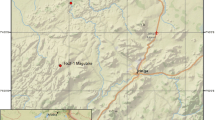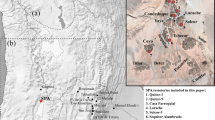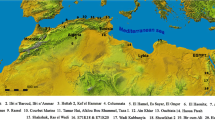Abstract
Neolithic stone tool production in Sudan was quite diverse but exhibited high standards of production, as exemplified by the adze-like artifacts called “gouges”. Drawing on data from several sites in Jebel Sabaloka, and comparative data from Shaheinab and Sheikh el-Amin, our paper examines the economy of gouge production from a technological point of view. More specifically, we discuss the process of gouge production and distribution through the study of raw material sourcing and methods of manufacture. We determine that the Neolithic people of central Sudan preferred rhyolites for the manufacture of gouges and that the production was highly standardized. We also examine the implications of gouge production for understanding Neolithic social networks in the region.
Résumé
La production néolithique d’outils en pierre au Soudan était très variée mais respectait des normes technologiques élevées, comme en témoignent des artefacts en forme dherminette appelés «gouges». En utilisant des données de plusieurs sites à Jebel Sabaloka, et des données comparatives des sites de Shaheinab et de Sheikh el-Amin, notre article examine l’économie de la production de gouges d’un point de vue technologique. Plus spécifiquement, nous discutons du processus de production et de distribution des gouges, y compris l’approvisionnement en matière première et les méthodes de fabrication. Nous déterminons que le peuple néolithique du Soudan central a préféré les rhyolites pour la fabrication des gouges, et que la production était hautement standardisée. Nous examinons également les implications pour la compréhension des réseaux sociaux néolithiques dans la région.






















Similar content being viewed by others
References
Almond, D. C., & Ahmed, F. (1993). Field guide to the geology of the Sabaloka Inlier, Central Sudan. Khartoum: Khartoum University Press.
Arkell, A. J. (1949). Early Khartoum. An account of the excavation of an early occupation site carried out by the Sudan Government Antiquities Service in 1944–5. London: Oxford University Press.
Arkell, A. J. (1953). Shaheinab. An account of the excavation of a Neolithic occupation site carried out for the Sudan Antiquities Service in 1949–50. London: Oxford University Press.
Aubry, T., Bradley, B., Almeida, M., Walter, B., Neves, M. J., Pelegrin, J., Lenoir, M., & Tiffagom, M. (2008). Solutrean laurel leaf production at Maîtreaux: An experimental approach guided by techno-economic analysis. World Archaeology, 40(1), 48–66.
Caneva, I. (Ed.). (1988). El Geili: The history of a Middle Nile environment, 7000 B.C.-A.D. 1500. BAR International Series, 424. Oxford.
Caton-Thomson, G., & Gardner, E. W. (1934). The Desert Fayum. London: Royal Anthropological Institute of Great Britain and Ireland.
Fernández, V. M. (Ed.). (2003). The Blue Nile Project. Holocene archaeology in Central Sudan. Complutum 14. Madrid: Servicio de Publicaciones, Universidad Complutense.
Fernández, V. M., Jimeno, A., & Menéndez, M. (2003). Archaeological excavations in prehistoric sites of the Blue Nile, Central Sudan. In V. M. Fernández (Ed.), The Blue Nile Project. Holocene archaeology in Central Sudan (pp. 273–344). Complutum 14. Madrid: Servicio de Publicaciones, Universidad Complutense.
Haaland, R. (1982). Migratory herdsmen and cultivating women: The structure of Neolithic seasonal adaptations in the Khartoum Nile environment. Ph.D. Thesis. University of Bergen, Bergen.
Inizan, M. L., Reduron, M., Roche, H., & Tixier, J. (1999). Technology and Terminology of knapped stone. Meudon: Cercle de Recherches et d’Etudes Préhistoriques.
Kobusiewicz, M. (2011). Lithic implements. In M. Chłodnicki, M. Kobusiewicz, & K. Kroeper (Eds.), Kadero. The Lech Krzyżaniak Excavations in the Sudan (pp. 267–297). Poznań: Poznań Archaeological Museum.
Krzyżaniak, L. (1995). Late prehistory of the Central Sudan: A summary of the results of the last thirty years. Cahiers de recherches de l’Institut de papyrology et d’égyptologie de Lille, 17(1), 117–122.
Magid, A. A. (1989). Plant domestication in the Middle Nile Basin. An archaeoethnobotanical case study. British Archaeological Reports 523, Cambridge Monographs in African Archaeology 35. Oxford.
Magid, A. A. (2003). Exploitation of food-plants in the early and middle Holocene Blue Nile area, Sudan and neighbouring areas. In V. M. Fernández (Ed.), The Blue Nile Project. Holocene archaeology in central Sudan (pp. 345–372). Complutum 14. Madrid: Servicio de Publicaciones, Universidad Complutense.
Pelegrin, J. (1984). Experiments in bifacial work: About ‘laurel leaves’. Flintknappers Exchange, 4(1), 4–7.
Pelegrin, J. (1991). Aspects de la demarche expérimentale en technologie lithique. In 25 ans d’études technologiques en Préhistoire: Bilan et perspectives (XIémes rencontres internationals d’Archéologie et d ‘Histoire d’Antibes) (pp. 57–63). Juan-les-Pins: APDCA.
Pelegrin, J. (2007). Réflexions sur la notion de «spécialiste» dans la taille de la pierre au Paléolithique. Documents Préhistoriques, 16, 315–318.
Pelegrin, J. (2012). Observations sur la taille et le polissage de haches en silex. In P.-A. de Labriffe & É. Thirault (Eds.), Produire des haches au néolithique: De la matière première à l’abandon (pp. 87–106). Saint Germaine en Laye: Musée d’Archéologie Nationale.
Pelegrin, J. (2013). Les grandes feuilles de laurier et autres objets particuliers du Solutréen: Une valeur de signe. In Le Solutréen… 40 ans après Smith. Revue archéologique du Centre de la France 47 (pp. 143–164). Tours: ARCHEA-FERACF.
Pétrequin, P., Pétrequin, A.-M., Jeudy, F., Jeunesse, C., Monnier, J.-L., Pelegrin, J., & Praud, I. (1998). From the raw material to the Neolithic stone axe. Production processes and social context. In M. R. Edmonds & C. Richards (Eds.), Understanding the Neolithic of north-western Europe (pp. 277–312). Glasgow: Cruithne Press.
Schiffer, M. B. (1987). Formation processes of the archaeological record. Albuquerque: University of New Mexico Press.
Sobotková, A., Ross, S., Nehrizov, G., & Weissová, B. (2010). Tundzha regional archaeological project Kazanluk survey: Preliminary report. Spring 2009 and 2010. Studia Hercynia, 14, 56–66.
Suková, L., & Varadzin, L. (2012). Preliminary report on the exploration of Jebel Sabaloka (West Bank), 2009–2012. Sudan & Nubia, 16, 118–131.
Tixier, J. (1962). Le “Ténéréen” de l’Adrar Bous III. In H. J. Hugot (Ed.), Missions Berliet Ténéré, (pp. 353–362). Paris: Arts et Métiers graphiques.
Vail, J. R. (1982). Geology of the central Sudan. In M. A. J. Williams, M. A. J. Adamson, & D. A. Adamson (Eds.), A land between two Niles. Quaternary geology and biology of the Central Sudan (pp. 51–63). Rotterdam: A. A. Balkema.
Varadzinová, L., Varadzin, L., Kapustka, K., & Pacina, J. (2018). Výzkum lokality Liščí kopec (SBK.W-20) v pohoří Sabaloka: poznatky z výzkumné sezóny 2017. Pražské egyptologické studie, 20, 35–45.
Varadzinová, L., Varadzin, L., Crevecoeur, I., Kapustka, K., McCool, J.-P., & Sůvová, Z. (2019). Výzkum pravěkého osídlení v pohoří Sabaloka v centrálním Súdánu: poznatky z výzkumné sezóny 2018. Pražské egyptologické studie, 22, 43–53.
Acknowledgments
We thank Abdelrahman Ali Mohamed (General Director of the National Corporation for Antiquities and Museums of the Sudan), Ghalia el-Nabi (Director of the Sudan National Museum in Khartoum), Sarah Abdulatif and other curators of the Sudan National Museum, and Víctor M. Fernández (Department of Prehistory, University Complutense of Madrid, Director of the Blue Nile Project). Our research would not have been possible without their help and cooperation.
Funding
The research for this paper was conducted as part of the Communities and resources in late prehistory of Jebel Sabaloka, central Sudan: from analysis to synthesis project supported by the Czech Science Foundation (no. GAČR 17-03207S). Our research was also supported by the Institute of Geology CAS, Prague RVO 67985831, and the Institute of Archaeology CAS, Prague RVO: 67985912.
Author information
Authors and Affiliations
Corresponding author
Ethics declarations
Conflict of Interest
The authors declare that they have no conflict of interest.
Additional information
Publisher’s Note
Springer Nature remains neutral with regard to jurisdictional claims in published maps and institutional affiliations.
Archaeological period: Early Neolithic, ca. 4900–3800 cal. BC
Country and region discussed: Central Sudan, Nile Valley, Jebel Sabaloka
Rights and permissions
About this article
Cite this article
Kapustka, K., Lisá, L., Bajer, A. et al. Gouges: Iconic Artifacts of the Early Neolithic Period in Central Sudan. Afr Archaeol Rev 36, 505–534 (2019). https://doi.org/10.1007/s10437-019-09352-y
Published:
Issue Date:
DOI: https://doi.org/10.1007/s10437-019-09352-y




